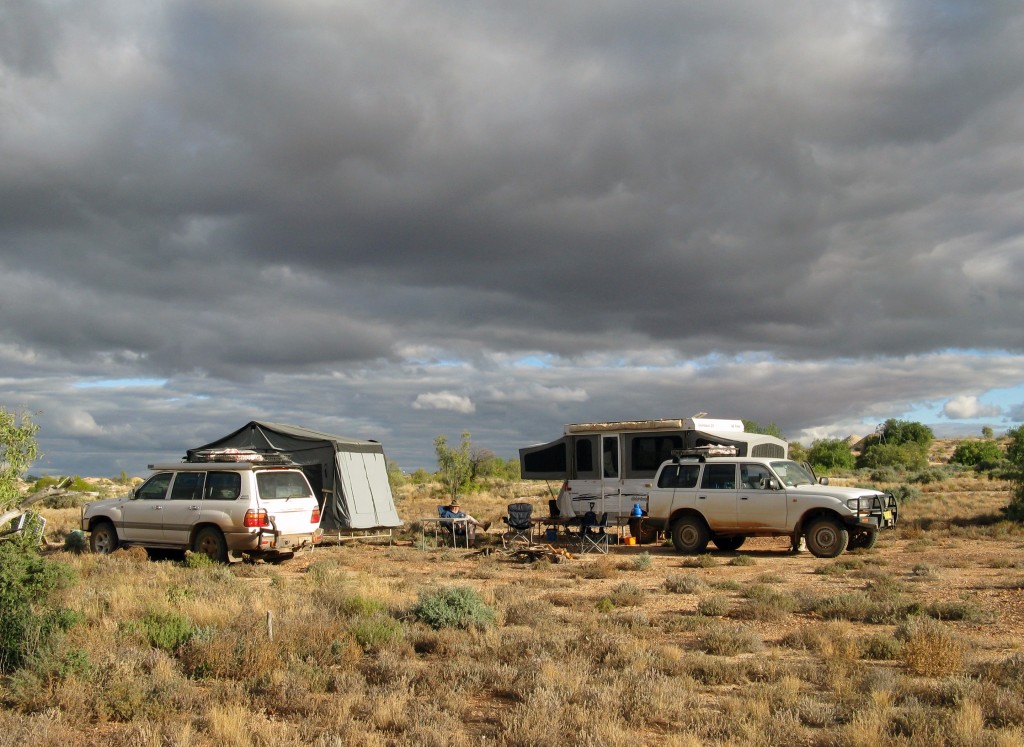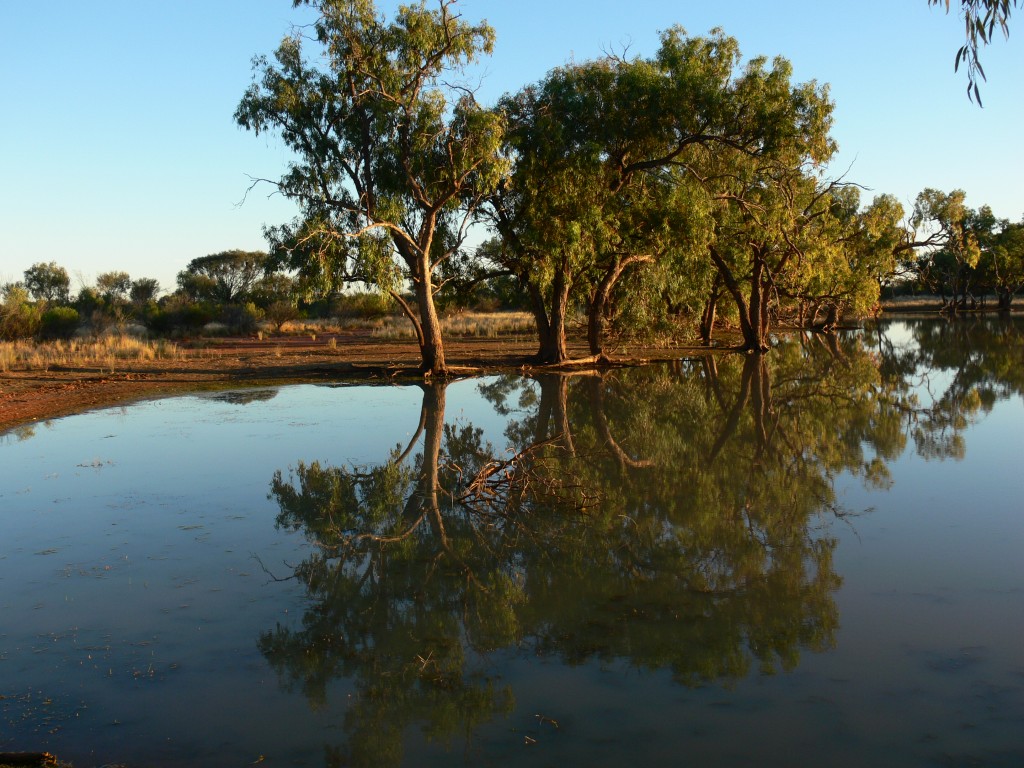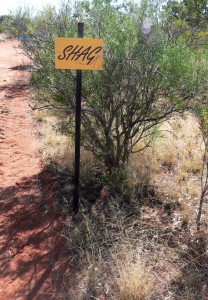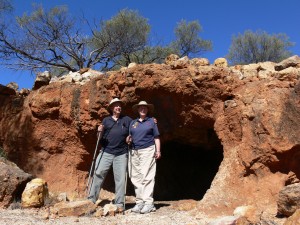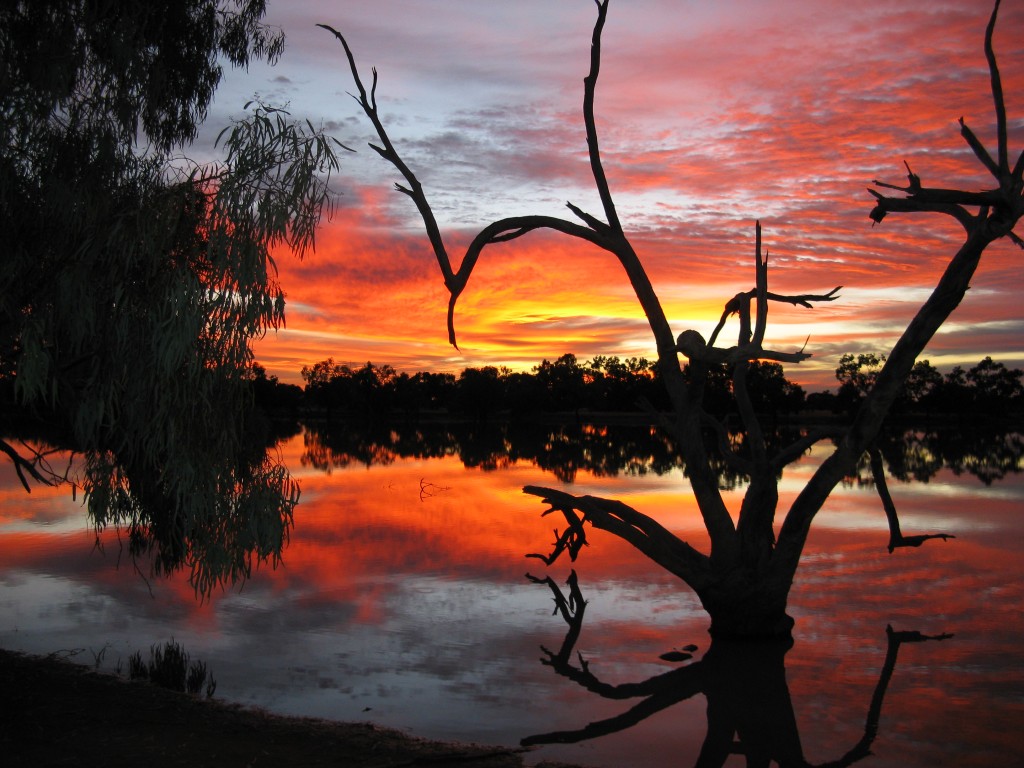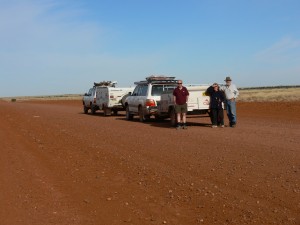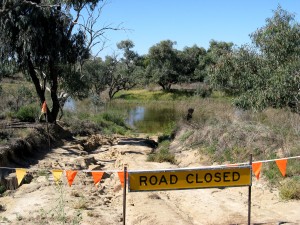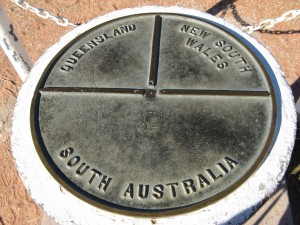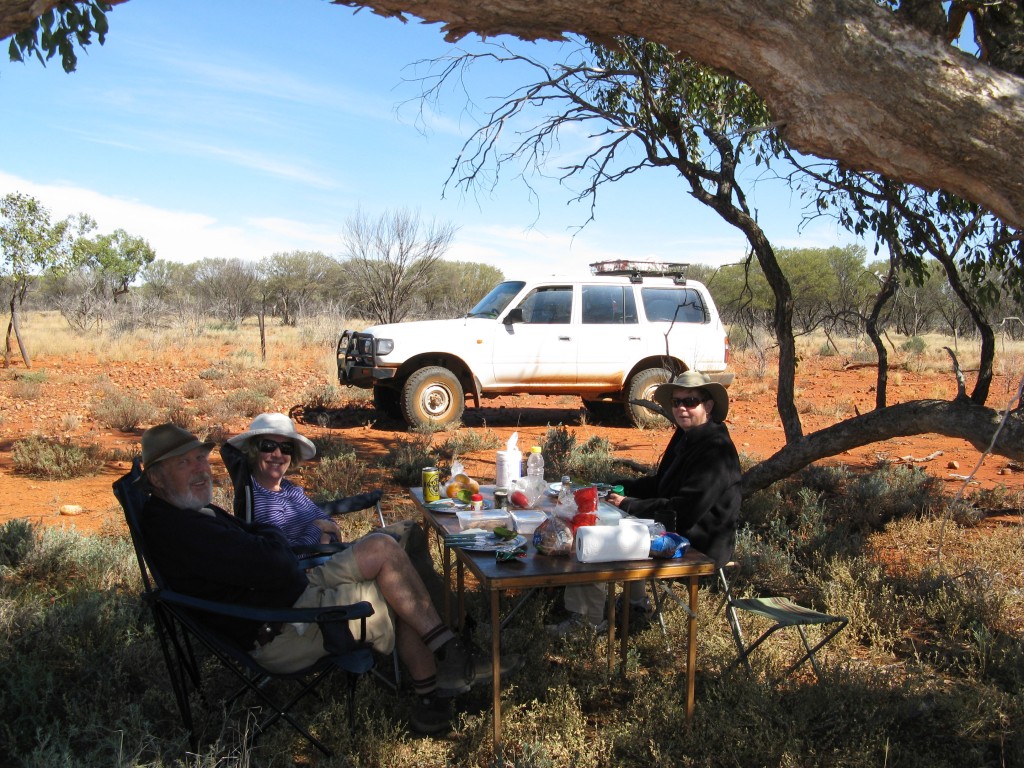IN THE FOOTSTEPS OF EXPLORERS
Caravan+RV Oct/Nov 2010 Issue
It is 150 years since Burke and Wills set out on their ill-fated attempt to cross the continent, Tim & Ros Bowden followed some of their footsteps to ‘Corner Country’, where South Australia, Queensland and New South Wales intersect.
We headed off from our base at Boomerang Beach, on the Mid North Coast of NSW intending to have our first camp at Kwiamble National Park, about 60 kilometres north of Inverell – for no other reason than a friend recommended it. In first gear we ground our way 2000 metres up onto the range via Thunderbolts Way. We tootled along in intermittent showers and bursts of sun passing the sodden grazing territory with full dams and fat cattle through the rolling hills to Walcha and Uralla.
May is generally a good time to travel, although we quickly found the nights were becoming nippy as we headed away from the coast. We were travelling with friends, Dermot and Hilary Hatfield, who have a Series 100 Landcruiser and an off-road Cub trailer. We, as usual, were driving ‘Penelope’ (our much loved Series 80 Landcruiser) towing ‘The Palace’ – an off-road Goldstream Sovereign camper. Contact car-to-car was via under-powered walkie-talkies which managed about 400 metres with luck on the bitumen, but proved useless when we hit the dirt.
We made good time to Lemon Tree Flat campground in Kwiamble National Park by 3.30 pm and camped on a grassy bank beside the idyllic Severn River. Less than idyllic though was noticing that Penelope’s rear passenger side back tyre was almost flat, but I thought that could wait till the morning. A wok full of chicken and noodles plus a few reds seemed a good morale booster. We decided to stay an extra day in the park before making a bee-line to Bourke for some tyre business. But we have another emergency.
Narrow winding roads led out of the Kwiamble National Park towards Warialda and Moree. I had been fretting about tyres. With with split rims, grit sometimes gets in between the tube and the casing and wears a hole in the tube. I decided to ask the tyre man in Bourke to replace the tubes in both rear tyres on Penelope as well as the spare as we were heading into rough country. He said he would, but why didn’t I have tubeless tyres? I would have far less trouble.
‘Old blokes used to think they could change split rims in an emergency, but really the technology has moved on’, he said.
I thought to myself that this old bloke couldn’t even do that, and made a mental note to move to tubeless when I got back home.
We were heading north-west to Hungerford on the Queensland border to overnight and then drive 100 km further on to camp for three nights on a cattle property that welcomes visitors, Kilcowera Station. The sky still looked threatening, with dark clouds to the south-west where the weather is coming from. We were on red dirt now, with some stony sections, but managing to do 90 kph most of the time. The country still looked wet, with lagoons close to the road. On the edge of one I saw a rather bedraggled pelican looking balefully at three feral pigs trotting past it.
You have to open the gate to get into Queensland, for good reason. The gate is on the dog fence stretching along to the border (which we would eventually see again at Cameron Corner). There is a fine of $1000 if you don’t shut the gate. Hungerford is really the pub and a camping ground and not much else. The camping ground is excellent, grassed and with hot showers, all for a token fee while the pub not only sells liquor and food, but also diesel and petrol. At the camping ground we met a couple of blokes working for a Christian outreach organisation who were counselling distressed farmers in the area. Some borrowed extra money from the banks after years of drought, and were then wiped out by floods. One young local farmer committed suicide . These two men tred to give advice on financial management as well as general counselling. We wished them well.
It rained fairly heavily in the night and pooled on the dirt road north to Kilcowera Station. The previous day we had been seeing mirages of water on the road ahead. Now the water was real, and red gooey mud began splashing up on the front of The Palace. Warm sunshine soon dried the road, and we made contact with the station managers Greg and Toni Sherwin. Toni guided us to a superb camping site on the edge of Cardenyabba Lagoon, rich with water birds and yabbies and not another camper in sight.
We appreciated the open fronted long-drop with fabulous water views. One of the unexpected delights was a sign on a side-track simply titled ‘SHAG’. Very thoughtful wouldn’t you say? But further signs revealed locations to see other water birds like cranes, ducks, egrets. Ibis and cormorants. We spent two days doing self-drive tours of the station, including remarkable views over Lake Wyara in a nearby national park, with seemingly more pelicans and water birds than Lake Eyre. The station has intriguing features like Murderers Bore, scene of a grisly and elaborate murder. The Sherwins have an information kit that tells the full story.
We ran on to the bitumen just outside Thargomindah coinciding with a power failure in the town, but it came on in time to let us get much needed fuel – and news from the police that the Development Road to Innamincka was closed due to Coopers Creek being in full flood. All was not lost, though, as it was possible to reach Innamincka by a 200 k detour to the south and up again near the South Australian border.
I was absurdly keen to get to Innamincka and not only because I had never been there. The legendary compere Jack Davey used to threaten to send his radio quiz winners there in the 1950s for a ‘luxury’ weekend! I think it was either Innamincka or Marble Bar.
While getting some fast food at Thargo, Ros noticed a middle-aged man crawling around on his hands and knees under the serving counter. She asked him what he was doing.
He said he had dropped his glasses on the floor, and an all-important screw holding them together had dropped out. Ros said she thought she could help, and the man looked doubtful. ‘Look’, she said, diving into her handbag, ‘I always carry a glasses mending kit with spare screws and a tiny screwdriver, and here it is.’
He got to his feet, and said, ‘There wouldn’t be anyone a thousand kilometres in any direction from here who could supply something like that!’
We drove 150km to overnight over a narrow strip bitumen to camp by the lagoon near the Noccundra Hotel – which I dubbed Poo Corner because of the reeking contributions of the countless water birds in and on it, which had also fouled the available rough water near the bank. Rough water indeed. At the pub they confirmed that we would have to take a 200 k detour to get to Innaminka and recommended shortening the journey by taking a 63 k cross country track between Bransby Station and Santos’ Tickalara oil field.
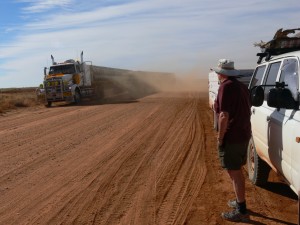
Detour to Innaminka on the Santos mining road – where the bulldust was so thick it even stopped a roadtrain!
We did, but the bulldust was so thick it actually stopped a road train driver in his tracks – he didn’t have the luxury of skirting the really bad bits. Once we turned north again, heading for the Development Road that would take us west into South Australia and Innamincka, the red-dirt track was quite good by outback standards.
In fact we were Cooper’s Draft at the Innamincka pub by 3.30pm before we retraced our route back to the turnoff to the Cullymerta water hole – a permit was needed – to spend the next three nights. Again waterbirds shared our waterfront camping site was shared by a profusion of water birds, but this time the steady flow of the swollen Cooper Creek kept the water muddy-looking but sweet and bird-poo free.
The mouse plague that had pestered us ever since our first night at Kwiamble National Park had reached Innamincka and the little pests seemed to have chewed into our 12v electrics under the camper, killing the system for the rest of our trip!
We had a great camp site, but we were woken at 4 am every morning by juvenile pelicans practicing noisy take-offs and landings just beside us. We heard dingos howling mournfully in the night too, but why howl with so many mice to eat?
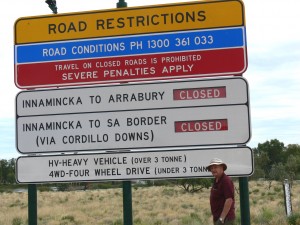
The John Flynn Hospital at Innamincka has been restored and is now a museum I was intrigued by one photograph showing the ginormous mound of empty bottles outside the pub in 1920.
Unfortunately the iconic Burke and Wills ‘Dig’ tree, on Nappa Merrie Station, was totally out of bounds – actually under water. We were, though, able to drive to the spot where John O’Hara Burke’s body was found in 1861 near Innamincka. There is a memorial marking the spot, in the shade of a coolibah tree that was certainly there at the time. John King was with him when he died, and Burke bizarrely instructed him to place a pistol in his outstretched hand presumably so when his body was found he would be seen to have died a heroic death.
It was the cruelest of coincidences, that after having successfully crossed the continent from south to north, the party that had been sent to meet Burke and Wills’ party left Coopers Creek only nine hours before on 21 April 1861. Had they waited another day, Burke and Wills would have been assured of fame and possibly fortune, as the first explorers to complete a return crossing of Australia.
The story is well known, but some new information has come to light from recent research done with the Aboriginal Yandruwandha people of the Coopers Creek area. The only survivor of the Burke and Wills northern party, John King, lived with in every sense of the word, because he had a child by an Yandruwandha woman, confirmed by a tribal elder, Aaron Patterson, who believes he himself is a descendant from that relationship.
According to the stories passed down, the Yandruwandha people were puzzled why Burke and Wills stayed by the Dig Tree when food became scarce. The Aborigines showed the white men how to grind and process nardoo seeds but failed to get through that they must wait till the seeds turn reddish brown, otherwise the nardoo was poisonous. They were also curious about the relationship between King and Burke and Wills, who were of course officers, and the younger King was effectively their servant. The Yandruwandha people thought King was behaving like a woman, serving the two older men.
For a while they gave the three men fish, but when they received nothing in return as custom dictated, they eventually gave up and moved on. Slowly starving, Burke and Wills compounded their plight by eating the immature but toxic nardoo seeds. When they died, the Yandruwandha people took in King to live with them, which is why he survived.
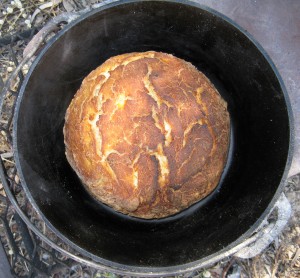
Heading south, still in South Australia, we skirted the Moomba gas field (appreciating their Telsra 3G signal to catch up on our emails en route) and eventually turned off near Merti Merti Station on a narrow but good track towards Cameron Corner, where the Queensland, South Australia and New South Wales state boundaries meet.
Since I was last there in the 1970s (driving a split-screen Kombi with trailer) the Cameron Corner ‘Store’ had been built, and we had a beer before taking the obligatory photographs of the Corner where the wild dog fences meet. We camped further into NSW at the Sturt National Park Fort Grey camping ground that sounded a better bet than Dead Horse Gully (although that actually looked quite attractive when we drove past it the next day.)
Sturt is an arid national park, with no fires allowed. Although a pretty spot, it turned on the mother of mouse plague evenings with the ground carpeted with a grey moving mass as soon as the sun set.
I finished up with a mouse in my sleeping bag – and I was in it at the time. A small bucket with a few inches of water in it attracted the attention of 12 mice who got in all right, but couldn’t get out and their drowned carcases greeted us in the morning.
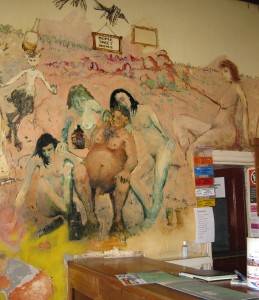
A yowling cat fight outside our camper at 1am could explain the lack of mice. We didn’t complain. Unfortunately the whole of Tibooburra was in the grip of a foul flu, which they managed to pass on to me.
Onward to the opal town of White Cliffs, where unbeknown to us, we had coincided with the first night of a three-day country and western music festival. Eschewing the caravan park, I took advice from a local and we headed to Potch Gulley just out of town to the north, where I was told, there was even a gratis long drop. It was all true, and we happily gathered around our own camp fire among the bare hills, where the distant sounds of country music could be heard.
Our friends, Hilary and Dermot, left us at Wilcannia, where we refuelled and set off down the western bank of the Darling towards the Menindee Lakes, happily scoring another lovely free camp site right on the shores of Lake Pamamaroo, full to the brim for the first time after a decade of drought.
We drove to the lakeside Kinchega National Park, created in 1967 and now Aboriginal managed, on the pastoral lease of Kinchega Station, held by the Hughes family since 1870. The former property is extremely well presented with excellent signage outlining its history. The last shearing was in 1967 when the sixth millionth sheep was fleeced!
A huge steam tractor parked outside the shed caught my eye. It had been there since the 1880s, to drive the first powered shears from an endless belt. Believe it or not this behemoth was originally ‘walked’ up from Melbourne to dig earth tanks to provide stock with water. However it proved to be as costly and slow to cart water to the boiler with bullock teams, as it was to use the teams themselves to dig the tanks. It took up its final duties as a power plant outside the wool shed until the 1920s when internal combustion engines took over.
Back at The Maidens Hotel in Menindee I facetiously said to the barman that it was a pity poor old Burke and Wills couldn’t have enjoyed a cold one or two before they took off on their fateful travels.
‘Well I’d be surprised if they didn’t’, he said. ‘It was certainly here when they went through in 1860.’
This journalist/traveller and so-called historian grabbed his beer and fled. In fact I went home after that – it seemed the only thing to do. It’s more than I can bear to tell the story here!
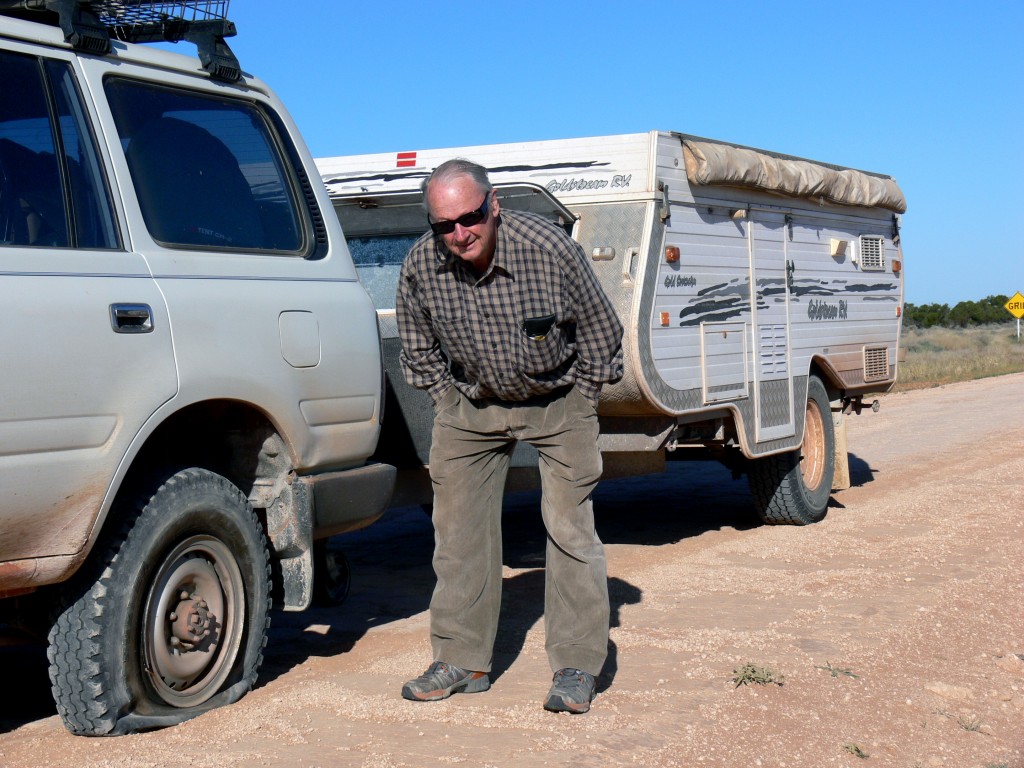
Oh dear – a rusty nail brought us to a halt on the Menindee to Wilcannia dirt road. Perhaps it is time I considered tubeless tyres after all.

